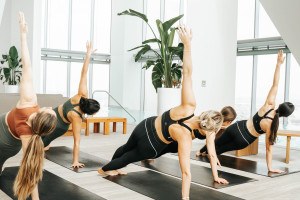Can’t Touch Your Toes? Here’s Why, According to a Philly Personal Trainer
Let’s face it: Most of us have something going on that we have been avoiding. No, I’m not talking about holiday shopping. I’m talking about that twinge in your back, the shoulder pain that wakes you from your sleep or the foot pain that hits you first thing in the morning. Whether you enjoy running, weight training, barre, yoga, or boot camps, there will inevitably be injuries. But what if we could prevent some of these injuries?
The first step is to take a minute to make sure you are moving properly during your workouts. Here are three quick assessments you can do right now to test your mobility.
Mobility Assessments
• Hips: One of the first fitness assessments I use with my clients is a simple toe touch. From a standing position, fold forward without bending your knees. Can you touch your toes? If the answer is no, why? Chances are that you don’t have tight hamstrings like you might think, but weak glutes. Our hamstrings act like the emergency breaks for our bodies. So if the main muscles that control our hips (our glutes) are not working properly, our hamstrings will take over to prevent injury.
You wouldn’t drive your car with the emergency brake on, so don’t ask your body to. Without being able to properly control the hips, your hamstrings and lower back will be asked to do too much of the work when lifting an object from the floor. So instead of doing deadlifts during your workouts, try bridges, clamshells, or one of my favorites, the Romanian deadlift. These are three safe and effective ways to work your way up to doing deadlifts properly.
• Shoulders: Do you have shoulder pain while doing an overhead press, push-up, pull-up or downward dog? Stand with your back against a wall and your feet six inches away from the wall. Your head, shoulders and hips should all be in contact with the wall. With your arms straight, raise both hands up toward the ceiling, palms facing each other, and try to touch your thumbs to the wall above your head. If this is an issue, try foam rolling the lats and retest. Foam rolling is a technique used to regain proper length in the muscle and break up any tightness to keep muscles and joints moving properly. Think of it as giving yourself a massage, but a bit more painful, and without the candles and spa vibes.
If we are lacking the ability to get into an overhead position, something is going on in the shoulder joint or the surrounding muscles. So, until you have the ability to go all the way overhead, skip the pull-ups and try rows with rings or a TRX. Pulling in a horizontal direction may be less stressful on the shoulder joint than pulling in a vertical position, with a lot of the same benefits.
• Ankles: Attention, runners! This one is for you. You may not give your ankles much thought, but think about this: Active people log between 10,000 and 15,000 steps per day. If we aren’t getting proper function out of our ankles, another area (knees, hips, back) will pick up the slack — and they won’t be happy about it.
So, how do you know if your ankles are functioning properly? Kneel on one knee facing a wall and set your toes five inches away from the wall. Slowly lean towards the wall and try and touch your kneecap to the wall (see an example here.) If you can touch the wall to your knee without your heel coming up, this is proper ankle mobility. If you can’t, foam roll the entire calf and then retest. If you still can’t do it, try trading squats for lunges until ankle mobility improves. Lunges target a lot of the same muscles as squats, but do not require the same amount of ankle mobility. Your knees and back will thank you later.
……………….
Pat Kempsey is the owner of Pat Kempsey Golf Fitness and Personal Training in Center City. He is a Certified Personal Trainer through the National Academy of Sports Medicine and the only Level 3 Titleist Performance Institute Fitness Professional in Philadelphia. You can contact him at pat@patkempsey.com
Like what you’re reading? Stay in touch with Be Well Philly—here’s how:
- Like Be Well Philly on Facebook
- Follow Be Well Philly on Twitter
- Follow Be Well Philly on Instagram
- Follow Be Well Philly on Pinterest
- Get the Be Well Philly Newsletter



